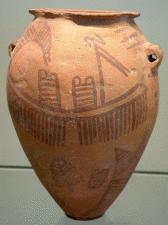Introduction
Pottery was created by the Egyptians from ancient times. It symbolizes a significant record and basis of analysis for realizing various ancient ages, but until comparatively newly, predynastic period pottery was less attractive for the Egyptologists. (Grimal, 1988).
The research of pottery and shards of pottery have contributed extremely to the study of all stages of Egyptian history, but mainly the predynastic periods. Ancient Egyptians resorted to pottery in much the similar way we use contemporary kitchen jugs, and by investigating the pottery material, equipment, and form of earliest pottery, archaeologists have been capable to date sites in Egypt where there is little other confirmation. Of course, contemporary radiocarbon dating has been of considerable precious for setting up complete dates, but early Egyptologists such as Flinders Petrie appeared capable to expand chronological dates for predynastic stages mainly based on pot splinters. (Grimal, 1988).
Features and classification
The pottery of predynastic Egypt was often of amazingly high quality. The pottery of the Badarian period was made without the use of a potter’s wheel, and it was usually the woman who turned out the pottery. These beautiful pieces were polished to a shiny finish and fired leaving a black upper section and lower, deep red section. They were perhaps fired in either open bonfires or very primitive ovens, but stay some of the most astounding pottery ever created in Egypt. From the Naqada period (4,000 – 3,000 BC) until the dynastic epoch, unguided paintings were supplementary to the pottery portraying animals, models, boats, and human shapes. (Baumgartel & Baumgartel, 1970).

As for the presented pot, it comprises all the mentioned above features. It is perfectly made and pictured. It is dated by the Naqada II period. This style of hand-made decoration depicts the belonging of this pot to the middle Naqada II period. And it is necessary to mention, that exactly this pot at the moment is stored in the Louvre Museum devoted to ancient Egyptian history, and in the Naqada II in particular. The ship theme depicts, that it belonged to a fisher, or someone, who was closely related to the sea. It can be seen that it has been manufactured without using the potter’s wheel. Most probably it was used for storing freshwater, but it also could be used for other liquids. (Baumgartel & Baumgartel, 1970). In the Naqada II epoch, also known as the Gerzean, pottery manufacturing enhanced considerably and there were plentiful improvements in form, decoration, and technology. The pottery, created throughout this stage, is featured by the use of pale clay, most probably pre-worked on a hand circle. The clay was left in its normal state and painted with red-painted motifs displaying various figures of the people’s everyday life.
This type of pottery within Egypt experienced some influence from Mesopotamia, probably via Palestine, in pottery painting and manufacturing styles, motifs and the first pot seals appeared in Egypt exactly under the influence of the neighboring civilizations. Pot seals have symbols that are known in Mesopotamia from the Late Uruk and Jamdat Nasr epochs as well as Mesopotamian settlement sites in Syria. (Baumgartel & Baumgartel, 1970).
Getting back to the regarded pot, it is necessary to emphasize, that probably it could be either shipped from or to somewhere, or it had been constantly used on a boat, as the researchers found the rests of the sea salt on the exterior walls of this pot. On the other side of the pommel another boat is displayed, the hull of which follows the camber of the handle. Two tall central cabins are shown on the boat and several banners. Next to the boat is a small, stylized aloe plant filling the available space. Not surprisingly in a country where all life depended on the Nile, boating scenes were frequently used as decorative elements from the Predynastic Period onwards.
References
Baumgartel Elise J. Baumgartel. Petrie’s Naqada Excavation, a Supplement. London, 1970.
Grimal, Nicolas. A History of Ancient Egypt. p.21. Librairie Arthéme Fayard, 1988.